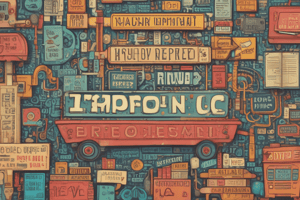Podcast
Questions and Answers
A bakery is considering adding a new type of pastry to its menu. Which microeconomic concept would be MOST helpful in determining if this addition would be profitable?
A bakery is considering adding a new type of pastry to its menu. Which microeconomic concept would be MOST helpful in determining if this addition would be profitable?
- Inflation rate
- Unemployment rate
- Gross Domestic Product (GDP)
- Marginal analysis (correct)
In a perfectly competitive market, what is the MOST likely outcome if a large number of new firms enter the market?
In a perfectly competitive market, what is the MOST likely outcome if a large number of new firms enter the market?
- The market price will decrease due to increased supply. (correct)
- The market price will fluctuate randomly as firms adjust to the competition.
- The market price will remain constant as competition has no effect.
- The market price will increase due to higher demand.
A city government is considering building a new public park. Which of the following microeconomic concepts is MOST relevant when evaluating the decision from society's perspective?
A city government is considering building a new public park. Which of the following microeconomic concepts is MOST relevant when evaluating the decision from society's perspective?
- The trade deficit
- The money supply
- Externalities (correct)
- The consumer price index
What is the MOST direct effect of an increase in the price of steel on the automobile market, assuming steel is a major input in car production?
What is the MOST direct effect of an increase in the price of steel on the automobile market, assuming steel is a major input in car production?
A local hardware store decides to offer a 20% discount on all power tools for one week. If the store observes a significant increase in power tool sales, which microeconomic concept BEST explains this phenomenon?
A local hardware store decides to offer a 20% discount on all power tools for one week. If the store observes a significant increase in power tool sales, which microeconomic concept BEST explains this phenomenon?
A pharmaceutical company holds a patent for a life-saving drug, granting it exclusive rights to produce and sell the drug. Which market structure BEST describes this situation?
A pharmaceutical company holds a patent for a life-saving drug, granting it exclusive rights to produce and sell the drug. Which market structure BEST describes this situation?
Sarah is deciding whether to work an extra shift at her job. She earns $20 per hour, but she would have to forgo attending a concert with friends that she values at $30. What is Sarah's opportunity cost of working the extra shift?
Sarah is deciding whether to work an extra shift at her job. She earns $20 per hour, but she would have to forgo attending a concert with friends that she values at $30. What is Sarah's opportunity cost of working the extra shift?
A firm is producing at a level where its marginal cost is greater than its marginal revenue. Based on microeconomic principles, what adjustment should the firm make to increase its profit?
A firm is producing at a level where its marginal cost is greater than its marginal revenue. Based on microeconomic principles, what adjustment should the firm make to increase its profit?
Which of the following scenarios BEST illustrates the concept of asymmetric information in a market?
Which of the following scenarios BEST illustrates the concept of asymmetric information in a market?
A community decides to implement a tax on plastic grocery bags to reduce litter. From a microeconomic perspective, this policy is PRIMARILY intended to address what?
A community decides to implement a tax on plastic grocery bags to reduce litter. From a microeconomic perspective, this policy is PRIMARILY intended to address what?
Flashcards
Microeconomics
Microeconomics
Focuses on individual economic agents and their resource allocation choices.
Supply
Supply
Quantity producers offer at different prices.
Demand
Demand
Quantity consumers are willing to buy at different prices.
Perfect competition
Perfect competition
Signup and view all the flashcards
Monopoly
Monopoly
Signup and view all the flashcards
Opportunity cost
Opportunity cost
Signup and view all the flashcards
Rationality
Rationality
Signup and view all the flashcards
Incentives
Incentives
Signup and view all the flashcards
Marginal analysis
Marginal analysis
Signup and view all the flashcards
Market failure
Market failure
Signup and view all the flashcards
Study Notes
- Economics is a social science that studies the production, distribution, and consumption of goods and services.
- It analyzes how individuals, businesses, governments, and nations make choices about allocating resources to satisfy their wants and needs, attempting to determine how these groups should organize and coordinate efforts to achieve maximum output.
- Economics includes microeconomics and macroeconomics
Microeconomics
- Microeconomics focuses on the behavior of individual economic agents, such as households, firms, and governments, and how their choices affect the allocation of scarce resources.
- It examines how these individual decisions and behaviors impact the supply and demand for goods and services, price determination, and market structures.
- Supply and demand are key concepts in microeconomics
- Supply refers to the quantity of a good or service that producers are willing and able to offer at different prices.
- Demand refers to the quantity of a good or service that consumers are willing and able to purchase at different prices.
- The interaction of supply and demand determines the market equilibrium price and quantity.
- Market structures describe the competitive environment in a market, ranging from perfect competition to monopolies.
- Perfect competition involves many buyers and sellers, homogeneous products, and free entry and exit.
- In a monopoly, a single seller dominates the market.
Key Concepts in Microeconomics
- Opportunity cost: The value of the next best alternative forgone when making a decision.
- Rationality: The assumption that individuals make decisions to maximize their own well-being or utility.
- Incentives: Factors that motivate individuals to act in a certain way.
- Marginal analysis: Comparing the additional benefits and costs of a decision.
- Elasticity: Measures the responsiveness of one variable to a change in another, such as price elasticity of demand.
- Market failure: Situations where the market fails to allocate resources efficiently, leading to suboptimal outcomes.
- Externalities: Costs or benefits that affect parties not directly involved in a transaction.
- Public goods: Non-excludable and non-rivalrous goods, often under-provided by the market.
- Asymmetric information: Situations where one party has more information than another, leading to adverse selection or moral hazard.
- Game theory: Analyzes strategic interactions between individuals or firms, considering their interdependence.
- Production theory: Examines how firms combine inputs to produce outputs, considering costs and efficiency.
- Cost theory: Studies the various costs incurred by firms in the production process, including fixed, variable, and marginal costs.
- Consumer behavior: Analyzes how consumers make choices based on preferences, budget constraints, and prices.
- Utility maximization: The goal of consumers to obtain the highest level of satisfaction given their resources.
- Behavioral economics: Integrates psychological insights into economic models to better understand decision-making.
- Welfare economics: Evaluates the social desirability of different economic outcomes, focusing on efficiency and equity.
- Economic efficiency: Achieving the maximum possible output from available resources.
- Equity: The fairness of the distribution of resources and outcomes.
Studying That Suits You
Use AI to generate personalized quizzes and flashcards to suit your learning preferences.



